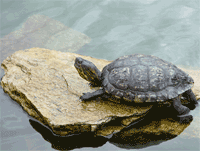 Do you know nothing about terrapin breeding? Just cool down dear terrapin lover…!
Do you know nothing about terrapin breeding? Just cool down dear terrapin lover…!
Here are some useful and handy tips and guidelines regarding one of the most frequently asked questions – “How to breed my pet terrapins”?
Step One:
Things you will need:
- A male terrapin
- A female terrapin
- One vermicular or an incubator
- One breeding box
Step Two:
Matrimony:
Have you got the couple of terrapins, a male and a female? Are your terrapins happy with each other? Well…, Cupid is also ready to strike!
A pair of sexually mature male and female terrapin is ideal for mating. Terrapins of 5 to 11 years of age are generally considered as the ‘Best’ provided they are reared in proper condition.
Step Three:
Provide the appropriate environment:
Terrapins need an environment combined of both aquatic and terrestrial condition but they breed inside water and lay eggs on the land. Specific temperature is necessary for the breeding and that differs from species to species.
Breeding terrapins outdoor is easy but may not be convenient all the times. Mimicking the outdoor environment with a few tricks can be a good alternative to make your terrapins comfortable.
Step Four:
The breeding box:
A comfortable box is what your female terrapin might be looking for. It might climb into it and get ready to lay eggs. Get your box ready with a near-natural condition of sand and moist soil (about 1 ft).
Step Five:
Get the wedding bells ring:
Prepare the atmosphere…
- Let them hibernate
- Keep the couple separate for a few months because re-union after a few months generally triggers the mating instinct…! After all ‘Absence makes the heart grow fonder’.
- An amazing fact – Your female terrapin may lay eggs years after mating as she can store sperms for more than three years! But this is a rare occurrence.
Step Six:
Handling and storing eggs:
Mark the top of the breakable eggs so that you can take extra caution and don’t flip them. Success rate of incubation in vermiculate is higher than in natural condition.
Temperature around the eggs determines the sex of the hatchlings. At 24 – 28º C males and at 30 – 32º C females are hatched. But shell deformities may occur at higher temperature.
Step Seven:
Hatchlings:
It takes 60 to 120 days to produce hatchlings. Separate them from the adults as they may kill the hatchlings. Give them a regular and well balanced food.

